Consultant’s report
VerifiedAdded on 2023/04/21
|8
|1917
|345
AI Summary
This consultant’s report discusses the importance of business ethics in leadership and management, analyzes potential risks for a new procurement agency, and suggests a democratic leadership model for a sustainable ethical organization.
Contribute Materials
Your contribution can guide someone’s learning journey. Share your
documents today.
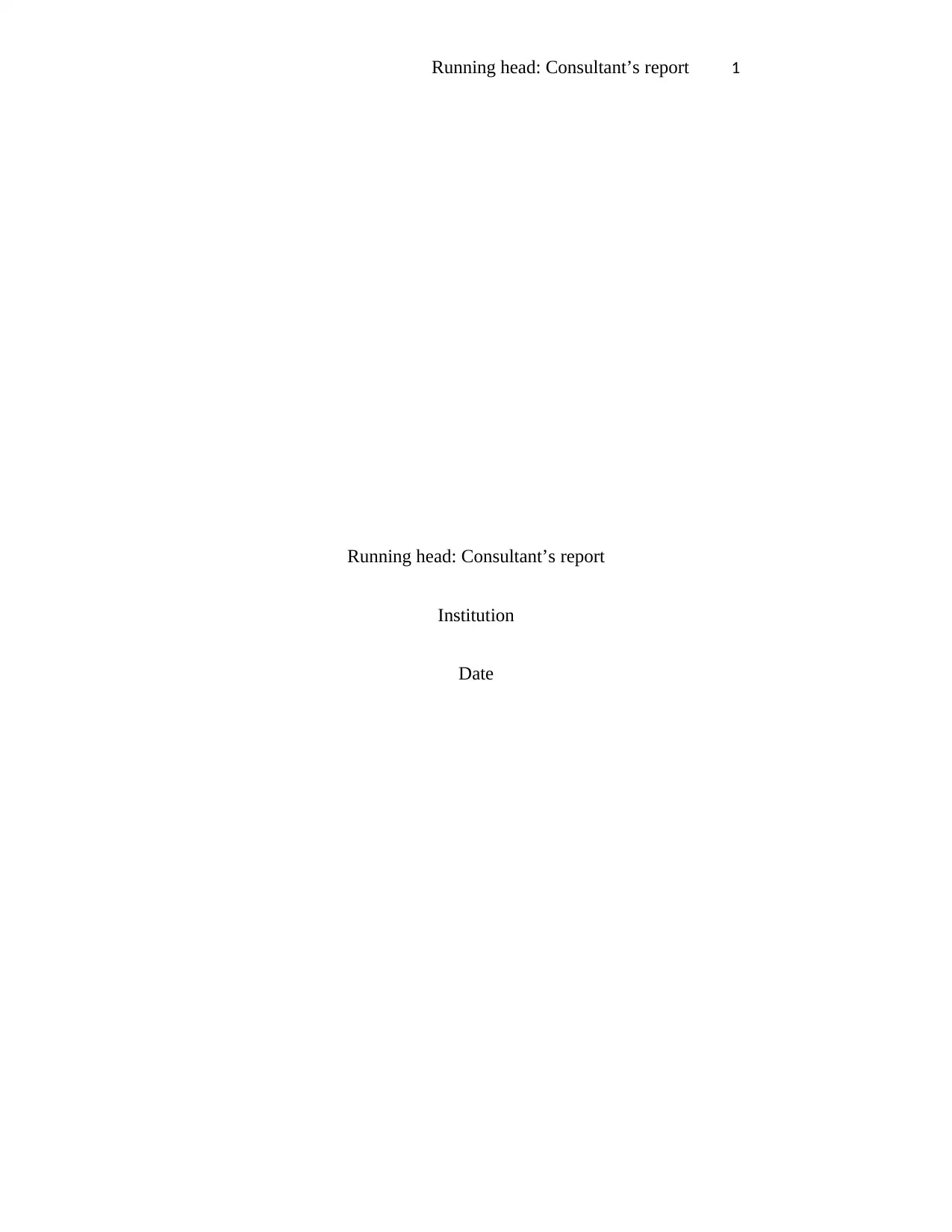
Running head: Consultant’s report 1
Running head: Consultant’s report
Institution
Date
Running head: Consultant’s report
Institution
Date
Secure Best Marks with AI Grader
Need help grading? Try our AI Grader for instant feedback on your assignments.
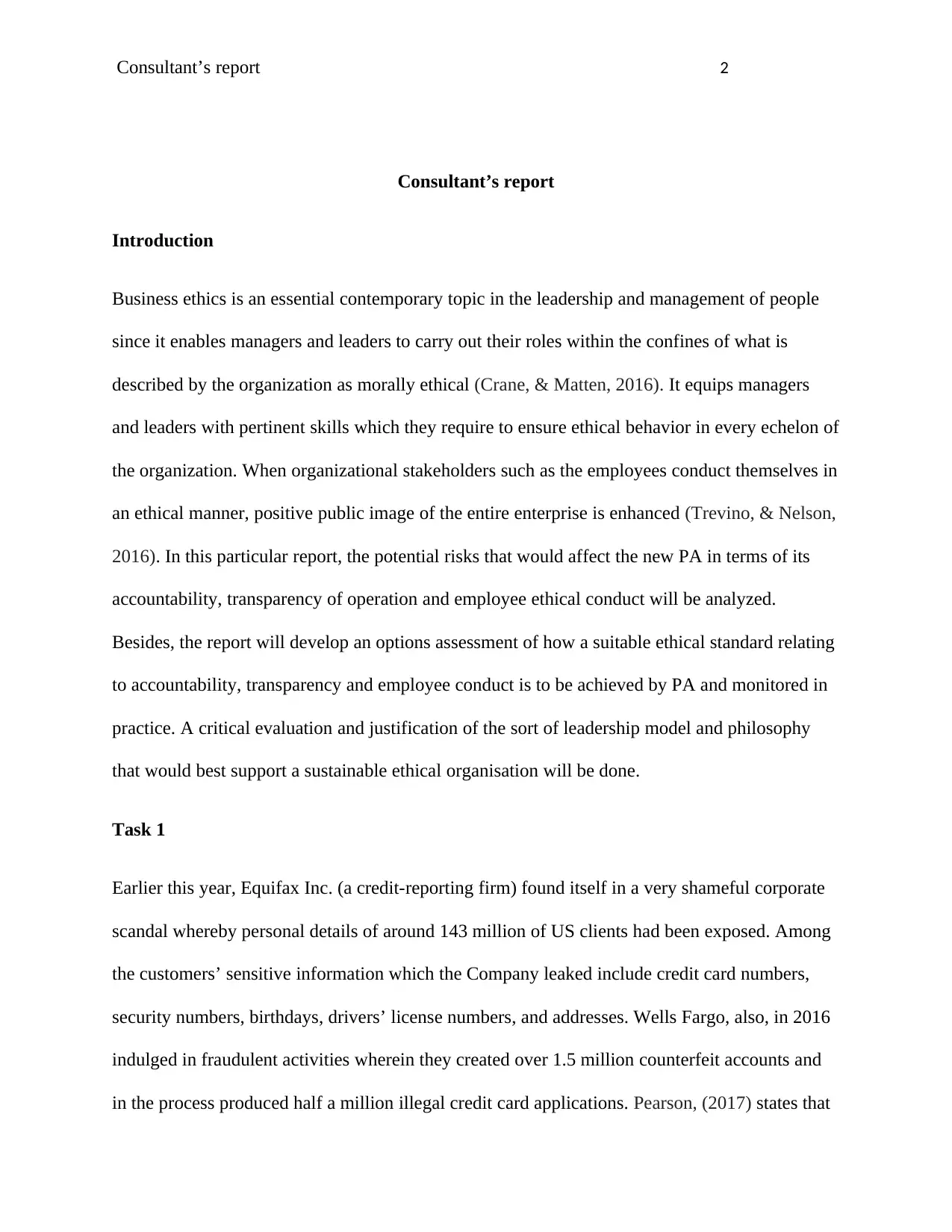
Consultant’s report 2
Consultant’s report
Introduction
Business ethics is an essential contemporary topic in the leadership and management of people
since it enables managers and leaders to carry out their roles within the confines of what is
described by the organization as morally ethical (Crane, & Matten, 2016). It equips managers
and leaders with pertinent skills which they require to ensure ethical behavior in every echelon of
the organization. When organizational stakeholders such as the employees conduct themselves in
an ethical manner, positive public image of the entire enterprise is enhanced (Trevino, & Nelson,
2016). In this particular report, the potential risks that would affect the new PA in terms of its
accountability, transparency of operation and employee ethical conduct will be analyzed.
Besides, the report will develop an options assessment of how a suitable ethical standard relating
to accountability, transparency and employee conduct is to be achieved by PA and monitored in
practice. A critical evaluation and justification of the sort of leadership model and philosophy
that would best support a sustainable ethical organisation will be done.
Task 1
Earlier this year, Equifax Inc. (a credit-reporting firm) found itself in a very shameful corporate
scandal whereby personal details of around 143 million of US clients had been exposed. Among
the customers’ sensitive information which the Company leaked include credit card numbers,
security numbers, birthdays, drivers’ license numbers, and addresses. Wells Fargo, also, in 2016
indulged in fraudulent activities wherein they created over 1.5 million counterfeit accounts and
in the process produced half a million illegal credit card applications. Pearson, (2017) states that
Consultant’s report
Introduction
Business ethics is an essential contemporary topic in the leadership and management of people
since it enables managers and leaders to carry out their roles within the confines of what is
described by the organization as morally ethical (Crane, & Matten, 2016). It equips managers
and leaders with pertinent skills which they require to ensure ethical behavior in every echelon of
the organization. When organizational stakeholders such as the employees conduct themselves in
an ethical manner, positive public image of the entire enterprise is enhanced (Trevino, & Nelson,
2016). In this particular report, the potential risks that would affect the new PA in terms of its
accountability, transparency of operation and employee ethical conduct will be analyzed.
Besides, the report will develop an options assessment of how a suitable ethical standard relating
to accountability, transparency and employee conduct is to be achieved by PA and monitored in
practice. A critical evaluation and justification of the sort of leadership model and philosophy
that would best support a sustainable ethical organisation will be done.
Task 1
Earlier this year, Equifax Inc. (a credit-reporting firm) found itself in a very shameful corporate
scandal whereby personal details of around 143 million of US clients had been exposed. Among
the customers’ sensitive information which the Company leaked include credit card numbers,
security numbers, birthdays, drivers’ license numbers, and addresses. Wells Fargo, also, in 2016
indulged in fraudulent activities wherein they created over 1.5 million counterfeit accounts and
in the process produced half a million illegal credit card applications. Pearson, (2017) states that
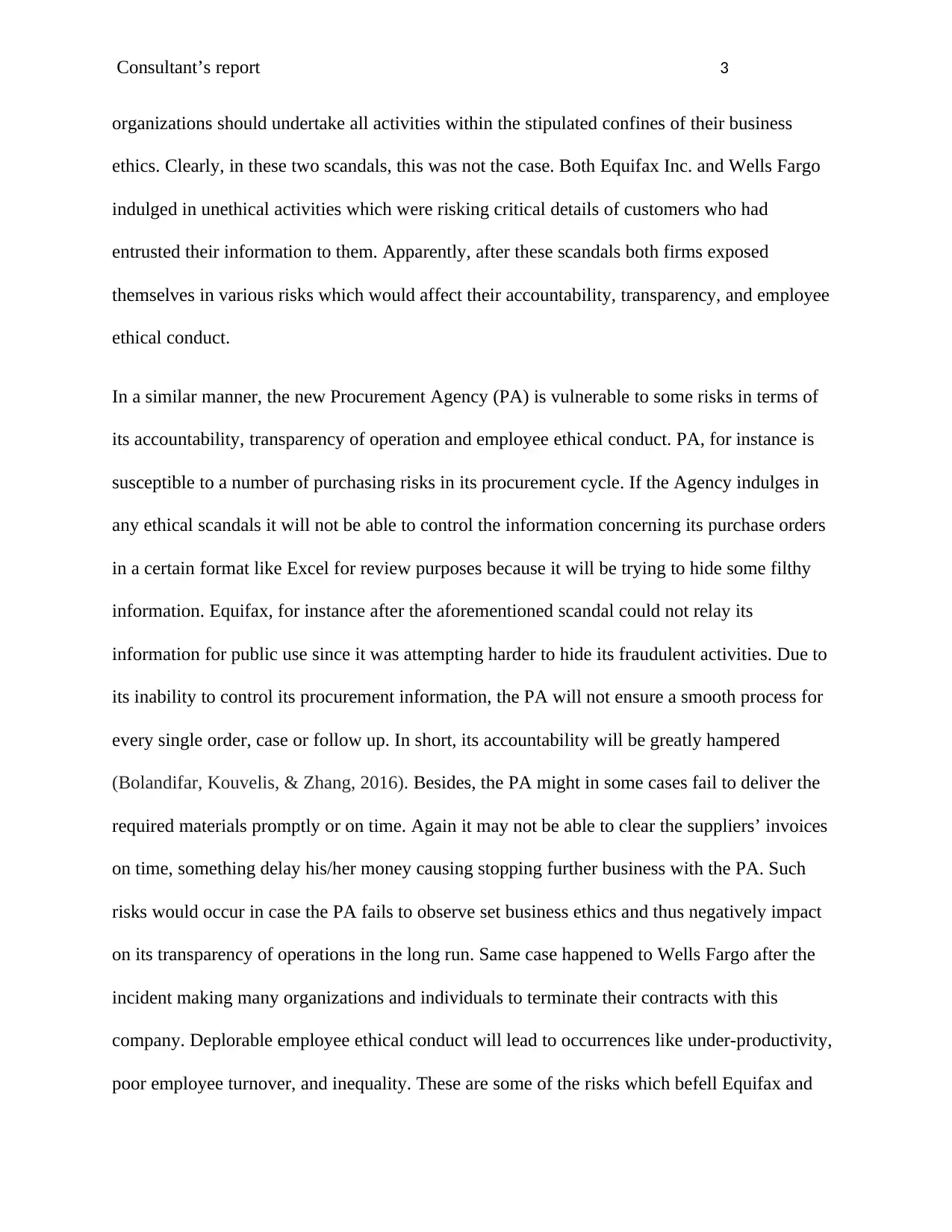
Consultant’s report 3
organizations should undertake all activities within the stipulated confines of their business
ethics. Clearly, in these two scandals, this was not the case. Both Equifax Inc. and Wells Fargo
indulged in unethical activities which were risking critical details of customers who had
entrusted their information to them. Apparently, after these scandals both firms exposed
themselves in various risks which would affect their accountability, transparency, and employee
ethical conduct.
In a similar manner, the new Procurement Agency (PA) is vulnerable to some risks in terms of
its accountability, transparency of operation and employee ethical conduct. PA, for instance is
susceptible to a number of purchasing risks in its procurement cycle. If the Agency indulges in
any ethical scandals it will not be able to control the information concerning its purchase orders
in a certain format like Excel for review purposes because it will be trying to hide some filthy
information. Equifax, for instance after the aforementioned scandal could not relay its
information for public use since it was attempting harder to hide its fraudulent activities. Due to
its inability to control its procurement information, the PA will not ensure a smooth process for
every single order, case or follow up. In short, its accountability will be greatly hampered
(Bolandifar, Kouvelis, & Zhang, 2016). Besides, the PA might in some cases fail to deliver the
required materials promptly or on time. Again it may not be able to clear the suppliers’ invoices
on time, something delay his/her money causing stopping further business with the PA. Such
risks would occur in case the PA fails to observe set business ethics and thus negatively impact
on its transparency of operations in the long run. Same case happened to Wells Fargo after the
incident making many organizations and individuals to terminate their contracts with this
company. Deplorable employee ethical conduct will lead to occurrences like under-productivity,
poor employee turnover, and inequality. These are some of the risks which befell Equifax and
organizations should undertake all activities within the stipulated confines of their business
ethics. Clearly, in these two scandals, this was not the case. Both Equifax Inc. and Wells Fargo
indulged in unethical activities which were risking critical details of customers who had
entrusted their information to them. Apparently, after these scandals both firms exposed
themselves in various risks which would affect their accountability, transparency, and employee
ethical conduct.
In a similar manner, the new Procurement Agency (PA) is vulnerable to some risks in terms of
its accountability, transparency of operation and employee ethical conduct. PA, for instance is
susceptible to a number of purchasing risks in its procurement cycle. If the Agency indulges in
any ethical scandals it will not be able to control the information concerning its purchase orders
in a certain format like Excel for review purposes because it will be trying to hide some filthy
information. Equifax, for instance after the aforementioned scandal could not relay its
information for public use since it was attempting harder to hide its fraudulent activities. Due to
its inability to control its procurement information, the PA will not ensure a smooth process for
every single order, case or follow up. In short, its accountability will be greatly hampered
(Bolandifar, Kouvelis, & Zhang, 2016). Besides, the PA might in some cases fail to deliver the
required materials promptly or on time. Again it may not be able to clear the suppliers’ invoices
on time, something delay his/her money causing stopping further business with the PA. Such
risks would occur in case the PA fails to observe set business ethics and thus negatively impact
on its transparency of operations in the long run. Same case happened to Wells Fargo after the
incident making many organizations and individuals to terminate their contracts with this
company. Deplorable employee ethical conduct will lead to occurrences like under-productivity,
poor employee turnover, and inequality. These are some of the risks which befell Equifax and
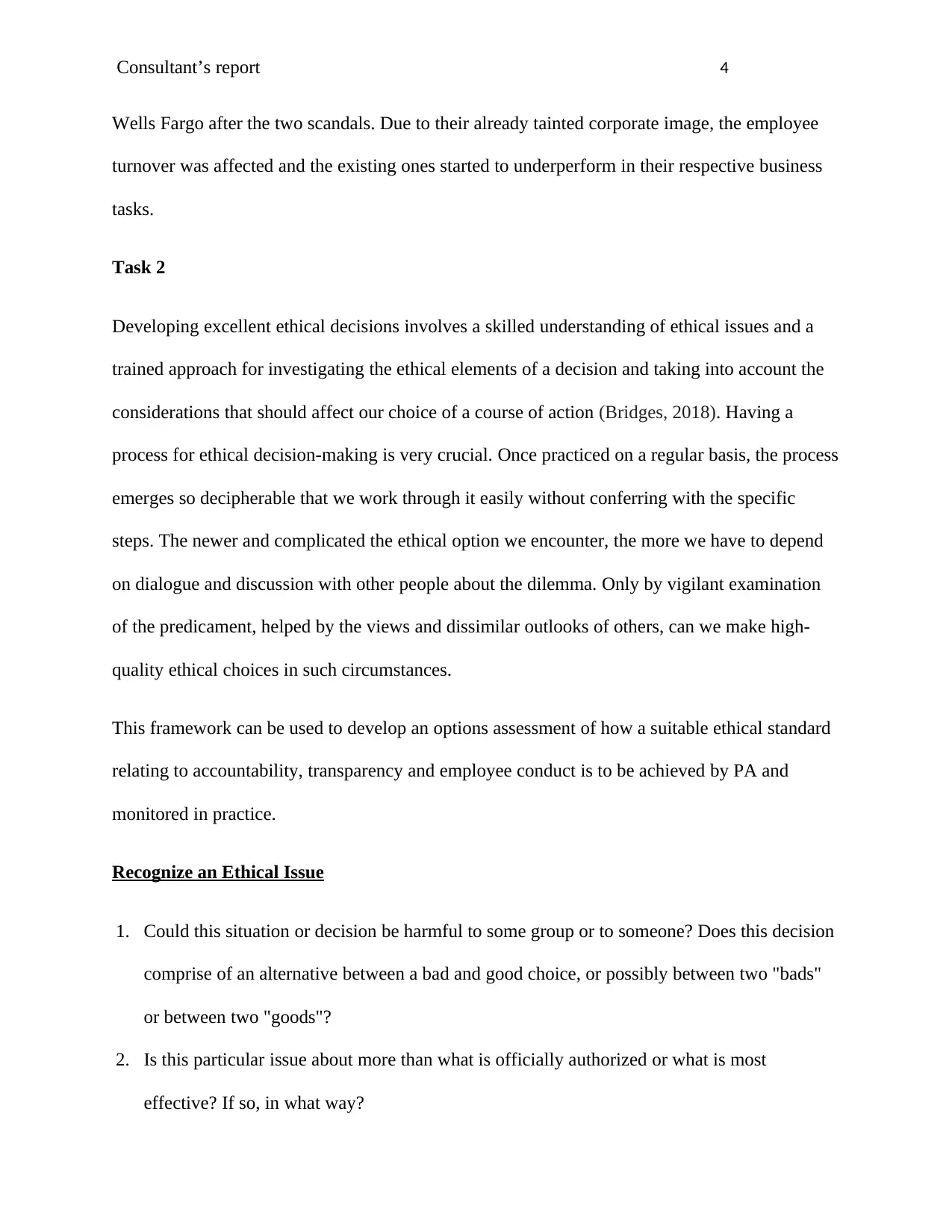
Consultant’s report 4
Wells Fargo after the two scandals. Due to their already tainted corporate image, the employee
turnover was affected and the existing ones started to underperform in their respective business
tasks.
Task 2
Developing excellent ethical decisions involves a skilled understanding of ethical issues and a
trained approach for investigating the ethical elements of a decision and taking into account the
considerations that should affect our choice of a course of action (Bridges, 2018). Having a
process for ethical decision-making is very crucial. Once practiced on a regular basis, the process
emerges so decipherable that we work through it easily without conferring with the specific
steps. The newer and complicated the ethical option we encounter, the more we have to depend
on dialogue and discussion with other people about the dilemma. Only by vigilant examination
of the predicament, helped by the views and dissimilar outlooks of others, can we make high-
quality ethical choices in such circumstances.
This framework can be used to develop an options assessment of how a suitable ethical standard
relating to accountability, transparency and employee conduct is to be achieved by PA and
monitored in practice.
Recognize an Ethical Issue
1. Could this situation or decision be harmful to some group or to someone? Does this decision
comprise of an alternative between a bad and good choice, or possibly between two "bads"
or between two "goods"?
2. Is this particular issue about more than what is officially authorized or what is most
effective? If so, in what way?
Wells Fargo after the two scandals. Due to their already tainted corporate image, the employee
turnover was affected and the existing ones started to underperform in their respective business
tasks.
Task 2
Developing excellent ethical decisions involves a skilled understanding of ethical issues and a
trained approach for investigating the ethical elements of a decision and taking into account the
considerations that should affect our choice of a course of action (Bridges, 2018). Having a
process for ethical decision-making is very crucial. Once practiced on a regular basis, the process
emerges so decipherable that we work through it easily without conferring with the specific
steps. The newer and complicated the ethical option we encounter, the more we have to depend
on dialogue and discussion with other people about the dilemma. Only by vigilant examination
of the predicament, helped by the views and dissimilar outlooks of others, can we make high-
quality ethical choices in such circumstances.
This framework can be used to develop an options assessment of how a suitable ethical standard
relating to accountability, transparency and employee conduct is to be achieved by PA and
monitored in practice.
Recognize an Ethical Issue
1. Could this situation or decision be harmful to some group or to someone? Does this decision
comprise of an alternative between a bad and good choice, or possibly between two "bads"
or between two "goods"?
2. Is this particular issue about more than what is officially authorized or what is most
effective? If so, in what way?
Secure Best Marks with AI Grader
Need help grading? Try our AI Grader for instant feedback on your assignments.
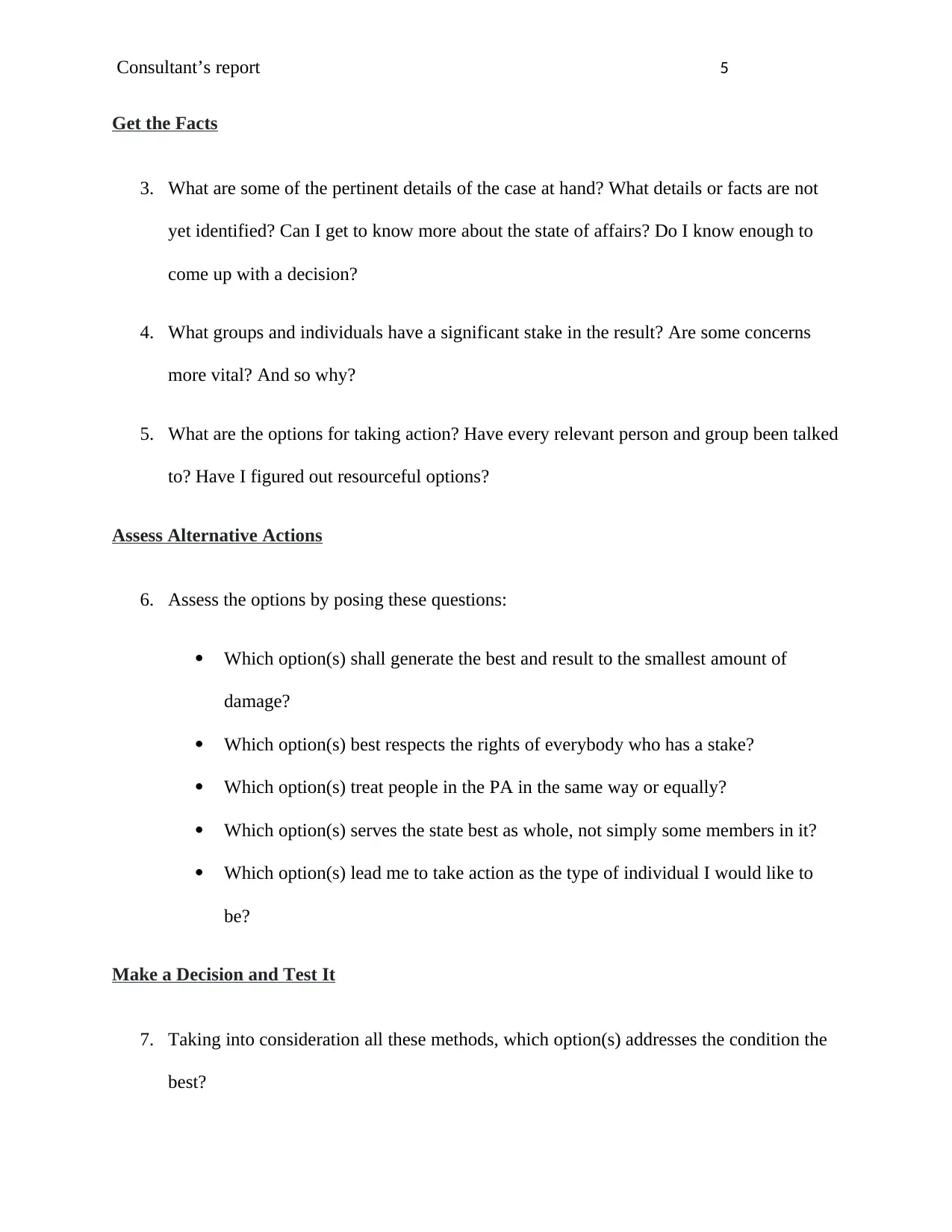
Consultant’s report 5
Get the Facts
3. What are some of the pertinent details of the case at hand? What details or facts are not
yet identified? Can I get to know more about the state of affairs? Do I know enough to
come up with a decision?
4. What groups and individuals have a significant stake in the result? Are some concerns
more vital? And so why?
5. What are the options for taking action? Have every relevant person and group been talked
to? Have I figured out resourceful options?
Assess Alternative Actions
6. Assess the options by posing these questions:
Which option(s) shall generate the best and result to the smallest amount of
damage?
Which option(s) best respects the rights of everybody who has a stake?
Which option(s) treat people in the PA in the same way or equally?
Which option(s) serves the state best as whole, not simply some members in it?
Which option(s) lead me to take action as the type of individual I would like to
be?
Make a Decision and Test It
7. Taking into consideration all these methods, which option(s) addresses the condition the
best?
Get the Facts
3. What are some of the pertinent details of the case at hand? What details or facts are not
yet identified? Can I get to know more about the state of affairs? Do I know enough to
come up with a decision?
4. What groups and individuals have a significant stake in the result? Are some concerns
more vital? And so why?
5. What are the options for taking action? Have every relevant person and group been talked
to? Have I figured out resourceful options?
Assess Alternative Actions
6. Assess the options by posing these questions:
Which option(s) shall generate the best and result to the smallest amount of
damage?
Which option(s) best respects the rights of everybody who has a stake?
Which option(s) treat people in the PA in the same way or equally?
Which option(s) serves the state best as whole, not simply some members in it?
Which option(s) lead me to take action as the type of individual I would like to
be?
Make a Decision and Test It
7. Taking into consideration all these methods, which option(s) addresses the condition the
best?
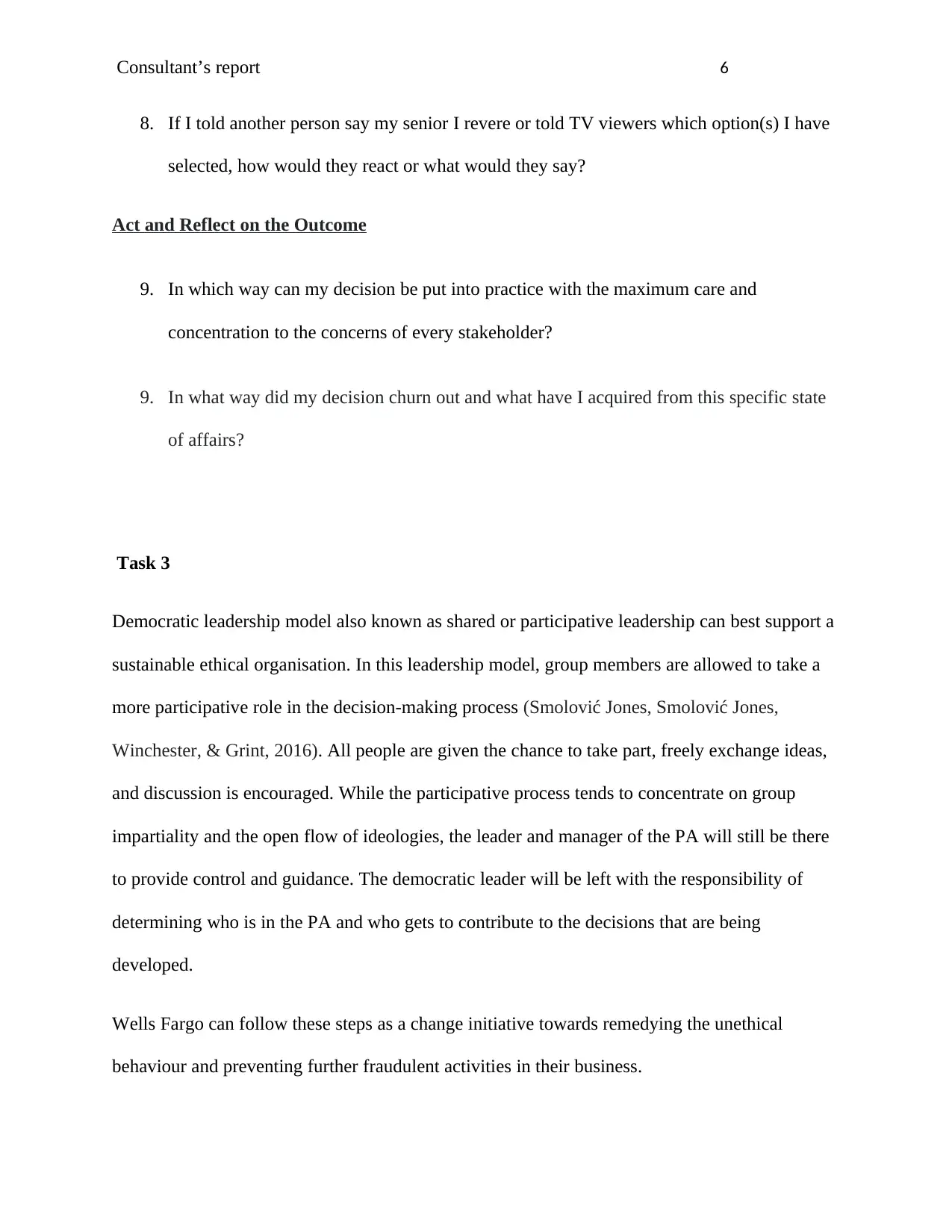
Consultant’s report 6
8. If I told another person say my senior I revere or told TV viewers which option(s) I have
selected, how would they react or what would they say?
Act and Reflect on the Outcome
9. In which way can my decision be put into practice with the maximum care and
concentration to the concerns of every stakeholder?
9. In what way did my decision churn out and what have I acquired from this specific state
of affairs?
Task 3
Democratic leadership model also known as shared or participative leadership can best support a
sustainable ethical organisation. In this leadership model, group members are allowed to take a
more participative role in the decision-making process (Smolović Jones, Smolović Jones,
Winchester, & Grint, 2016). All people are given the chance to take part, freely exchange ideas,
and discussion is encouraged. While the participative process tends to concentrate on group
impartiality and the open flow of ideologies, the leader and manager of the PA will still be there
to provide control and guidance. The democratic leader will be left with the responsibility of
determining who is in the PA and who gets to contribute to the decisions that are being
developed.
Wells Fargo can follow these steps as a change initiative towards remedying the unethical
behaviour and preventing further fraudulent activities in their business.
8. If I told another person say my senior I revere or told TV viewers which option(s) I have
selected, how would they react or what would they say?
Act and Reflect on the Outcome
9. In which way can my decision be put into practice with the maximum care and
concentration to the concerns of every stakeholder?
9. In what way did my decision churn out and what have I acquired from this specific state
of affairs?
Task 3
Democratic leadership model also known as shared or participative leadership can best support a
sustainable ethical organisation. In this leadership model, group members are allowed to take a
more participative role in the decision-making process (Smolović Jones, Smolović Jones,
Winchester, & Grint, 2016). All people are given the chance to take part, freely exchange ideas,
and discussion is encouraged. While the participative process tends to concentrate on group
impartiality and the open flow of ideologies, the leader and manager of the PA will still be there
to provide control and guidance. The democratic leader will be left with the responsibility of
determining who is in the PA and who gets to contribute to the decisions that are being
developed.
Wells Fargo can follow these steps as a change initiative towards remedying the unethical
behaviour and preventing further fraudulent activities in their business.
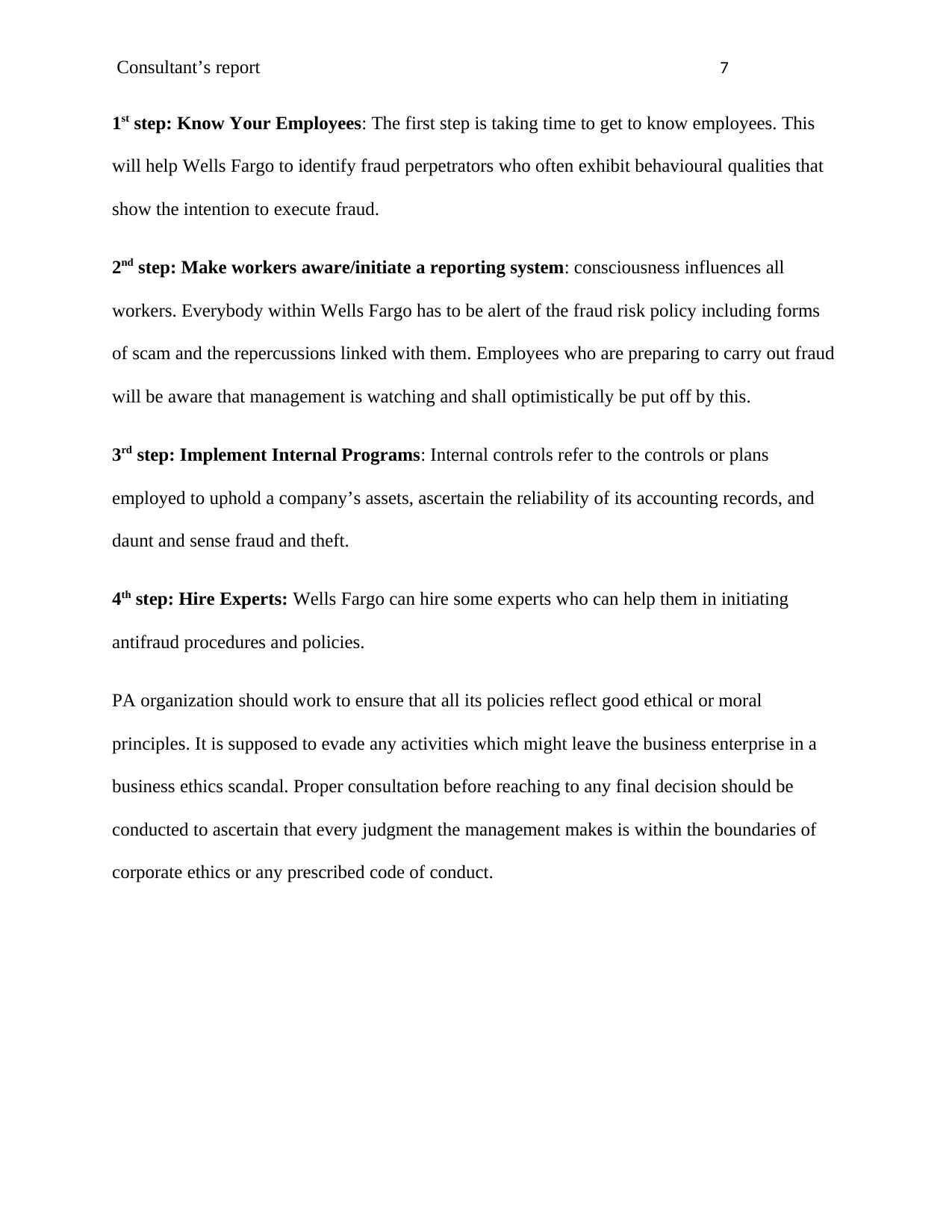
Consultant’s report 7
1st step: Know Your Employees: The first step is taking time to get to know employees. This
will help Wells Fargo to identify fraud perpetrators who often exhibit behavioural qualities that
show the intention to execute fraud.
2nd step: Make workers aware/initiate a reporting system: consciousness influences all
workers. Everybody within Wells Fargo has to be alert of the fraud risk policy including forms
of scam and the repercussions linked with them. Employees who are preparing to carry out fraud
will be aware that management is watching and shall optimistically be put off by this.
3rd step: Implement Internal Programs: Internal controls refer to the controls or plans
employed to uphold a company’s assets, ascertain the reliability of its accounting records, and
daunt and sense fraud and theft.
4th step: Hire Experts: Wells Fargo can hire some experts who can help them in initiating
antifraud procedures and policies.
PA organization should work to ensure that all its policies reflect good ethical or moral
principles. It is supposed to evade any activities which might leave the business enterprise in a
business ethics scandal. Proper consultation before reaching to any final decision should be
conducted to ascertain that every judgment the management makes is within the boundaries of
corporate ethics or any prescribed code of conduct.
1st step: Know Your Employees: The first step is taking time to get to know employees. This
will help Wells Fargo to identify fraud perpetrators who often exhibit behavioural qualities that
show the intention to execute fraud.
2nd step: Make workers aware/initiate a reporting system: consciousness influences all
workers. Everybody within Wells Fargo has to be alert of the fraud risk policy including forms
of scam and the repercussions linked with them. Employees who are preparing to carry out fraud
will be aware that management is watching and shall optimistically be put off by this.
3rd step: Implement Internal Programs: Internal controls refer to the controls or plans
employed to uphold a company’s assets, ascertain the reliability of its accounting records, and
daunt and sense fraud and theft.
4th step: Hire Experts: Wells Fargo can hire some experts who can help them in initiating
antifraud procedures and policies.
PA organization should work to ensure that all its policies reflect good ethical or moral
principles. It is supposed to evade any activities which might leave the business enterprise in a
business ethics scandal. Proper consultation before reaching to any final decision should be
conducted to ascertain that every judgment the management makes is within the boundaries of
corporate ethics or any prescribed code of conduct.
Paraphrase This Document
Need a fresh take? Get an instant paraphrase of this document with our AI Paraphraser
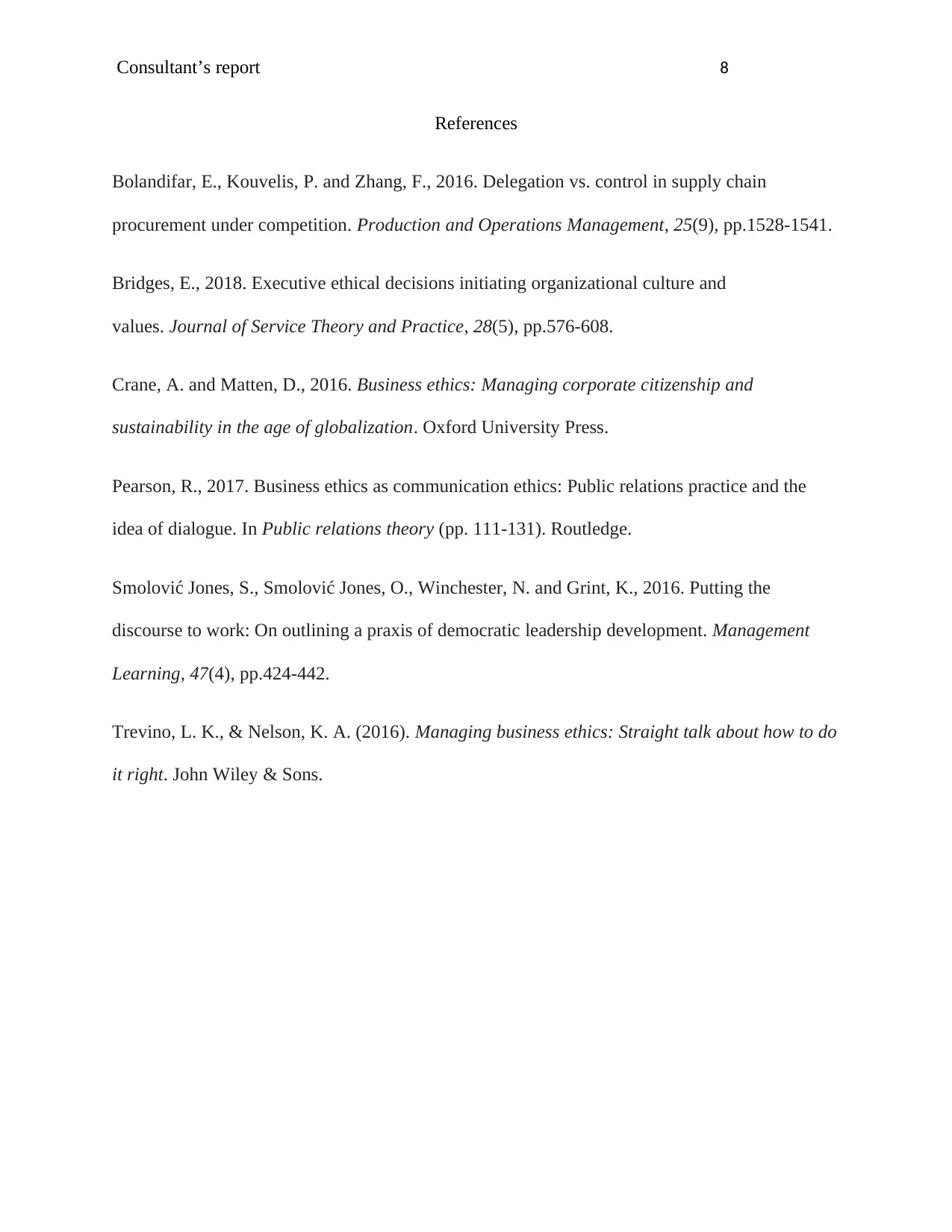
Consultant’s report 8
References
Bolandifar, E., Kouvelis, P. and Zhang, F., 2016. Delegation vs. control in supply chain
procurement under competition. Production and Operations Management, 25(9), pp.1528-1541.
Bridges, E., 2018. Executive ethical decisions initiating organizational culture and
values. Journal of Service Theory and Practice, 28(5), pp.576-608.
Crane, A. and Matten, D., 2016. Business ethics: Managing corporate citizenship and
sustainability in the age of globalization. Oxford University Press.
Pearson, R., 2017. Business ethics as communication ethics: Public relations practice and the
idea of dialogue. In Public relations theory (pp. 111-131). Routledge.
Smolović Jones, S., Smolović Jones, O., Winchester, N. and Grint, K., 2016. Putting the
discourse to work: On outlining a praxis of democratic leadership development. Management
Learning, 47(4), pp.424-442.
Trevino, L. K., & Nelson, K. A. (2016). Managing business ethics: Straight talk about how to do
it right. John Wiley & Sons.
References
Bolandifar, E., Kouvelis, P. and Zhang, F., 2016. Delegation vs. control in supply chain
procurement under competition. Production and Operations Management, 25(9), pp.1528-1541.
Bridges, E., 2018. Executive ethical decisions initiating organizational culture and
values. Journal of Service Theory and Practice, 28(5), pp.576-608.
Crane, A. and Matten, D., 2016. Business ethics: Managing corporate citizenship and
sustainability in the age of globalization. Oxford University Press.
Pearson, R., 2017. Business ethics as communication ethics: Public relations practice and the
idea of dialogue. In Public relations theory (pp. 111-131). Routledge.
Smolović Jones, S., Smolović Jones, O., Winchester, N. and Grint, K., 2016. Putting the
discourse to work: On outlining a praxis of democratic leadership development. Management
Learning, 47(4), pp.424-442.
Trevino, L. K., & Nelson, K. A. (2016). Managing business ethics: Straight talk about how to do
it right. John Wiley & Sons.
1 out of 8
Related Documents
Your All-in-One AI-Powered Toolkit for Academic Success.
+13062052269
info@desklib.com
Available 24*7 on WhatsApp / Email
![[object Object]](/_next/static/media/star-bottom.7253800d.svg)
Unlock your academic potential
© 2024 | Zucol Services PVT LTD | All rights reserved.





